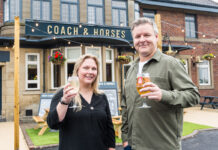
YOUR outlet needs a revamp but cash-flow is tight and funding is hard to come by – it’s a quandary familiar to many operators in the current economic climate.
And it’s one that seems to have spawned a very different approach to bar and restaurant design from that of five or ten years ago.
Design firms told SLTN the downturn and its resulting funding challenges have prompted operators – and interior designers – to push their creativity to the limit.
With capital tight and trading uncertain, radical refurbishments have given way to operators recycling existing features and materials as much as possible.
This trend, which has enabled operators to inject quirkiness and individuality into their venues, had begun to emerge before the recession.
But the economic climate has seen it gather pace.
Michael Dunn, boss of Design Build Deliver, confirmed there’s been a definite shift in the way operators approach refurbishments.
“Every pound is a prisoner now; people have the freedom to choose which pub or restaurant they spend that pound in and they expect high standards and a comfortable environment,” he told SLTN.
“Operators have to invest to maintain their premises and to get customers out of their homes and into bars; they’re competing against more comfortable homes and cheap supermarket alcohol prices.
“But they maybe want to spend £50,000 instead of £200,000 so we’re revising design schemes accordingly. We have to be more creative, challenge our suppliers and get a bigger bang for our buck.
“We’re working with existing features; walls and floors that, in the past, would have been ripped out are now being kept and enhanced.
“We’re working with what we’ve got and sourcing more second-hand tables and chairs and antiques.
“That kind of design often gives a venue a much more individual and eclectic feel and I think that’s going to become much more commonplace.”
Paula Murray, of design firm Supertonic, agreed that a squeeze on refurbishment budgets for bars and restaurants has encouraged a more creative approach – from both operators and designers.
“Smaller budgets can be quite exciting because it demands that the design team needs to be more creative with where the spend goes; it pushes us harder to find other ways to make good use of the space,” she said.
“This of course does still depend on a realistic budget.
“Regarding the physical aspects of bar or restaurant design, we, as a nation, are increasingly more relaxed about how ‘reclaimed’ a space can be. This doesn’t mean a project is done on a budget – often far from it.”
The importance of continuing to invest in premises was underlined by Edinburgh-based Ian Smith Design, whose recent projects include chef Martin Wishart’s brasserie, The Honours, in the capital, and eponymous restaurant in Leith.
“The message of the recession is: if you want to keep your clientele supporting you, invest in them; if not you will go down,” said marketing and business development manager Brian Saddler.
“Although our present projects are being done all at once, there is nothing wrong with refurbishing in phases; we are happy to do this.
“It also keeps the clientele interested and curious about the next phase and it gets them talking.”
It’s an approach recognised by Angus Alston, director at building contractor Hugh Stirling Ltd, who said refurbishing in phases allows premises to continue trading with minimal effect on customers.
Now is an excellent time to refurb as there’s more scope to achieve value for money.
Alston said the economic situation has also led to longer lead-in times before projects get underway as operators secure funding, ensure maximum value for money and consider all potential cost risks.
“None of this is really a bad thing as it means that the Is are all dotted and Ts crossed, which then reduces the risk, not only to operators, but the financiers as well as the contractors and suppliers,” he said.
“Certainly for any operator considering a refurb now is an excellent time.
“As fewer refurbishments are being carried out in the sector there is far more scope to achieve best value for money from the multitude of trades and suppliers involved.”
Ross Hunter, MD of Graven Images, also acknowledged that projects are taking longer to start, with some delayed due to funding.
“It’s always best to be strategic – be clear on the big picture of where you want to get to and work towards that incrementally rather than just making random ‘improvements’,” he said.
“It’s more important than ever to consider cost-in-use, and to maximise longevity.”



















